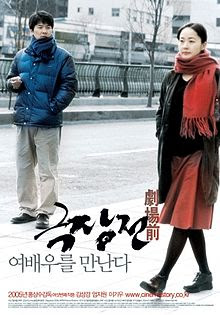(This post is in conjunction with the Museum of the Moving Image's retrospective, "Tales of Cinema: The Films of Hong Sang-soo," screening through June 19. Tale of Cinema screens on June 5, 7pm. For more information on the retrospective, and to purchase tickets, visit the museum's website.)
Tale of Cinema, Hong’s sixth feature, is an incredibly witty and playful meditation on the confluence of life and cinema. Over the course of seventeen films, Hong has created a unique and fascinating body of work, unabashedly auteurist and boldly inventive. From the start, Hong’s films existed in opposition to conventional methods of storytelling, and he makes use of a relatively limited set of character types and milieus (usually the filmmaking and academic worlds) to experiment with narrative structure in his films. Recurring patterns of human behavior, character and narrative mirroring, and repetition run throughout his films. Along with that, he offers funny, painful, awkward, and brutally honest depictions of male and female relationships.
Tale of Cinema added some intriguing new wrinkles to his cinematic strategy: this time (as the English title makes clear), cinema itself is his main subject matter. Similarly to some of his other films (The Power of Kangwon Province [1998], Virgin Stripped Bare By Her Bachelors [2000], Turning Gate[2002], Woman on the Beach [2006]), Tale of Cinema makes use of a bifurcated structure with echoes and mirrors in each half. However, while the structures of these other films serve to complicate and deepen our understanding of the characters and their situations, in this film we are invited to reflect on its own status as a cinematic object. To this end, Hong introduced some visual elements that have become stylistic hallmarks of his subsequent films, most prominently the frequent use of the zoom lens. The first time I saw Tale of Cinema (at the 2005 New York Film Festival), I found this quite disorienting, since Hong’s visual style up to that point consisted of minimal camera movement and practically no optical effects. Also new for Hong was the use of a voiceover and much more liberal use of non-diegetic music. All of these elements, including quotes from, and echoes of, his earlier films in Tale of Cinema serve to enhance our awareness that we are indeed watching a film, making what happens to the main character perhaps a cautionary tale.
Tale of Cinema has a loose, improvisational, and comic feel that is quite charming. In the first part of the film, an aimless student (Lee Ki-woo) meets up with a young woman (Uhm Ji-won) he has known in the past, and convinces her to join him in his quest to kill himself. However, things don’t quite go according to plan, as they often do in Hong’s films. In the second half, Tong-su (Kim Sang-kyung), a failed filmmaker, has become convinced that his successful and celebrated film-school classmate has stolen his life story to make one of his films. After watching this film again at a retrospective devoted to the director, he spots the film’s lead actress (Uhm Ji-won again) outside the theater, and begins to doggedly pursue her. For those who haven’t yet seen Tale of Cinema, I won’t reveal the connection between these two halves, since that would lessen the sense of discovery that is at the heart of this film’s considerable charm. Those familiar with Hong’s previous films will sense a subtle optimism that doesn’t exist in his earlier films. Hong, as usual, elicits engaging performances from his leads, Lee Ki-woo a natural as the childish and self-involved suicidal young man, Kim Sang-kyung (who also starred in Turning Gate) quite funny as the bizarre (and possibly delusional) wannabe director, and especially the strikingly beautiful Uhm Ji-won, who deftly pulls off her tricky dual role.







